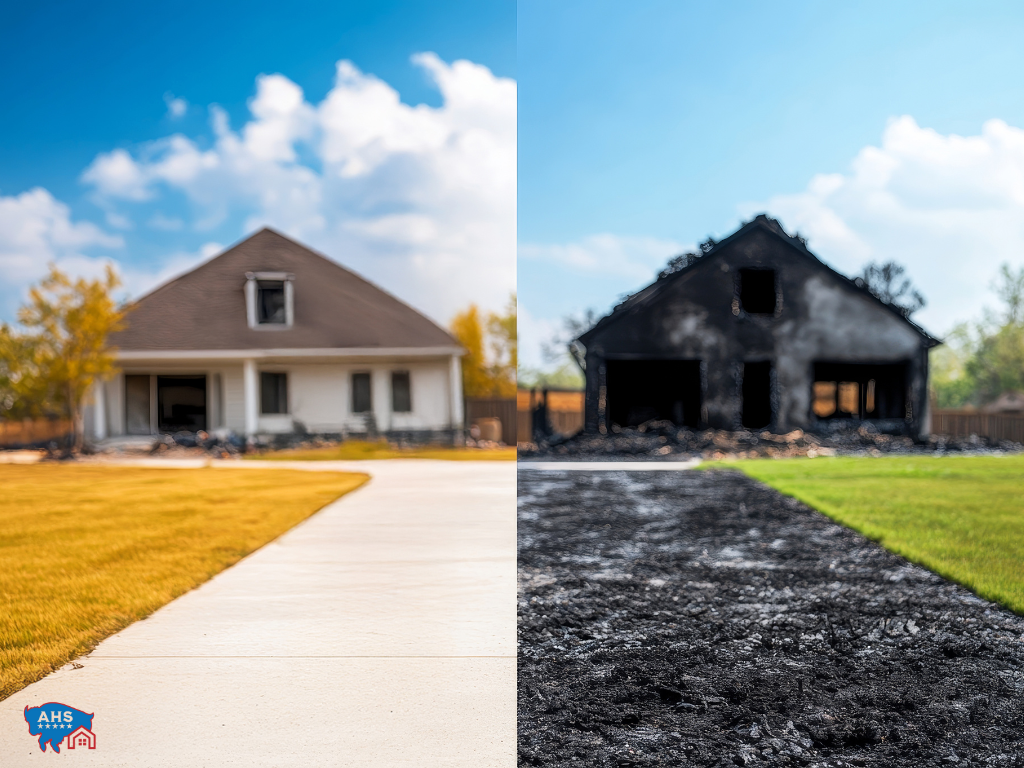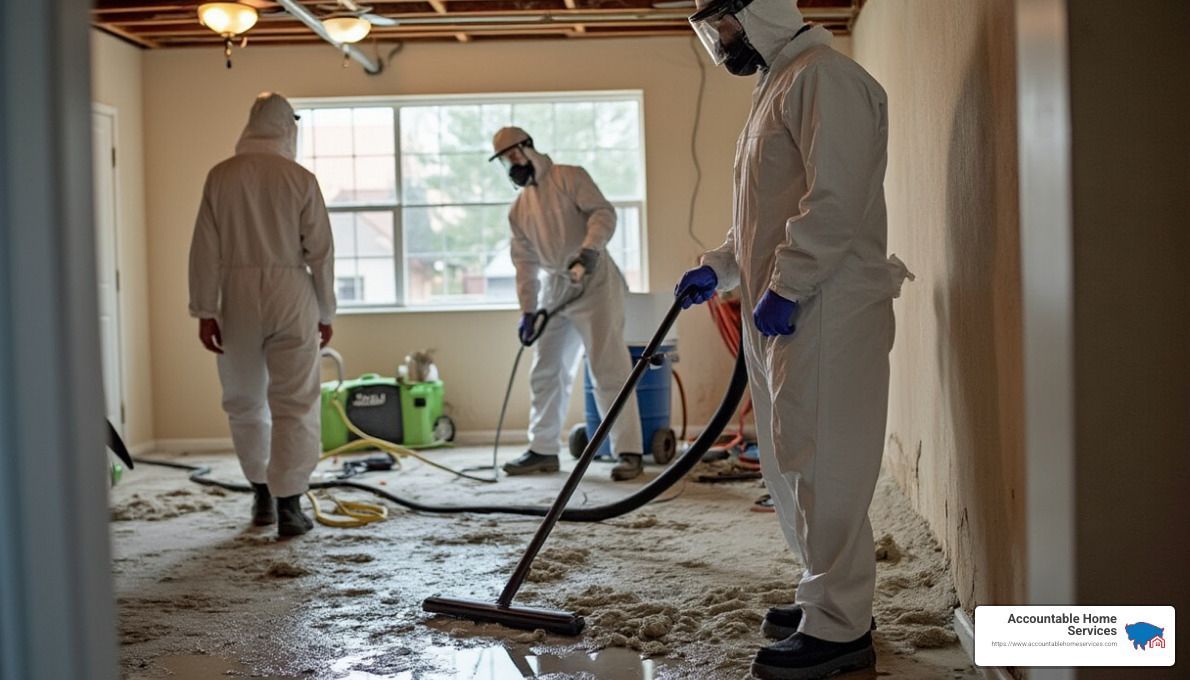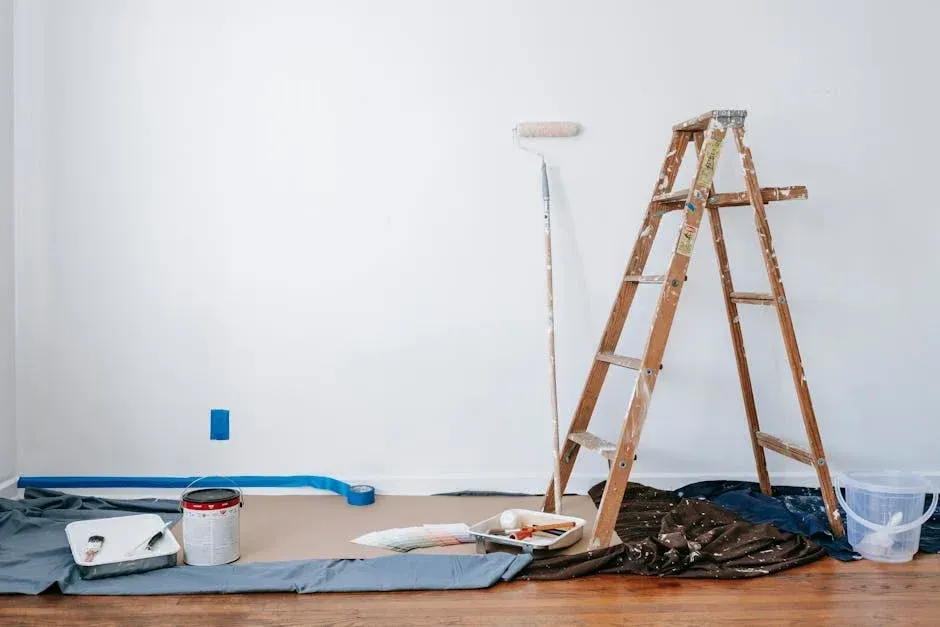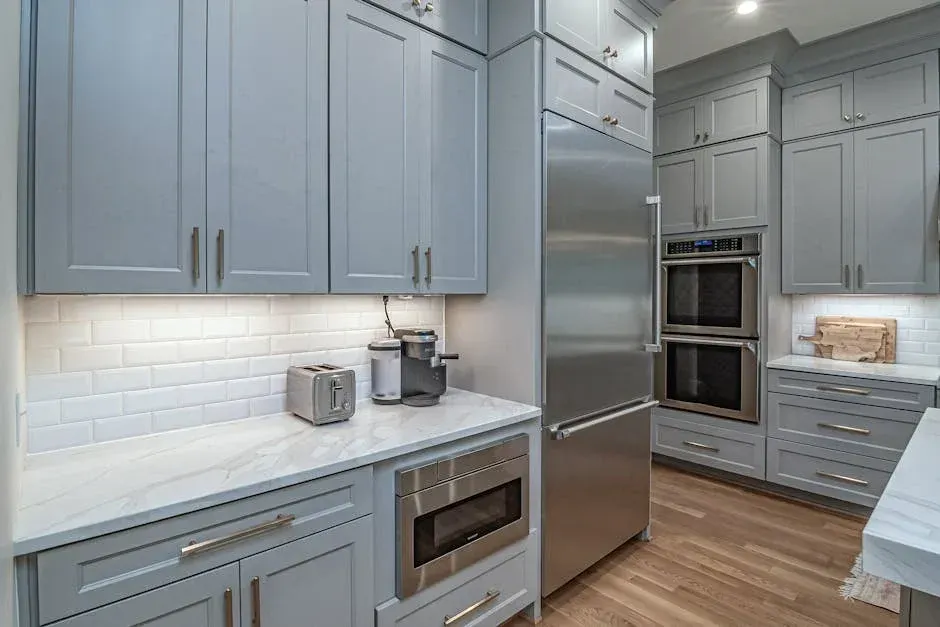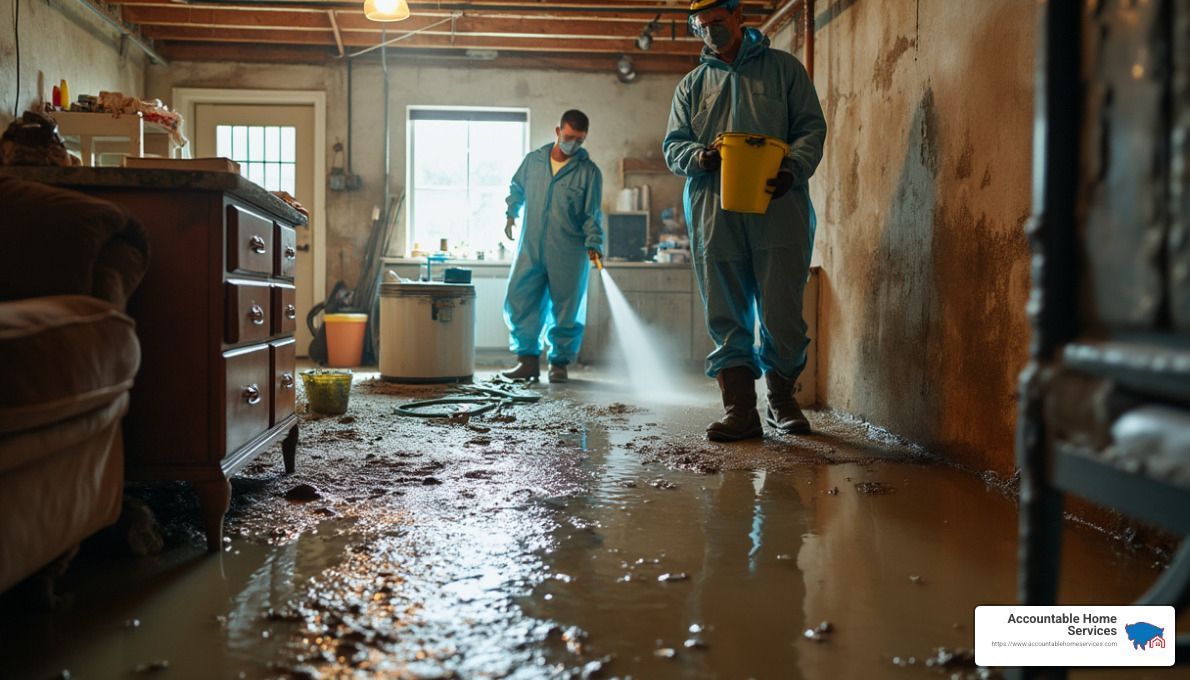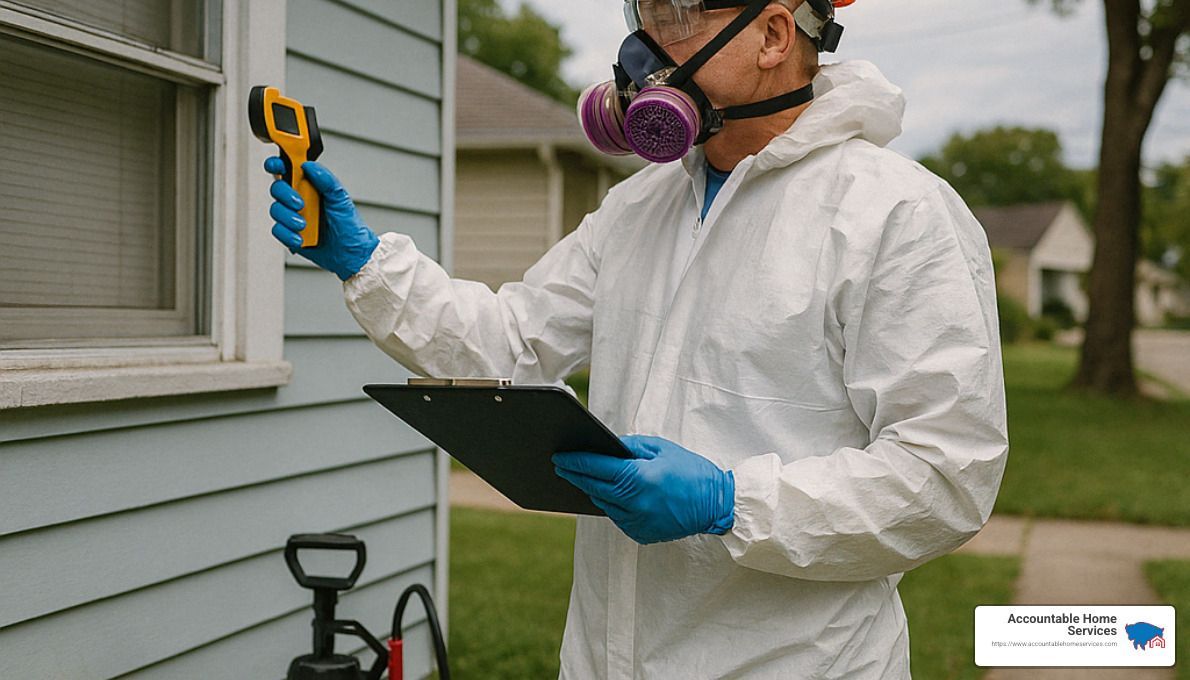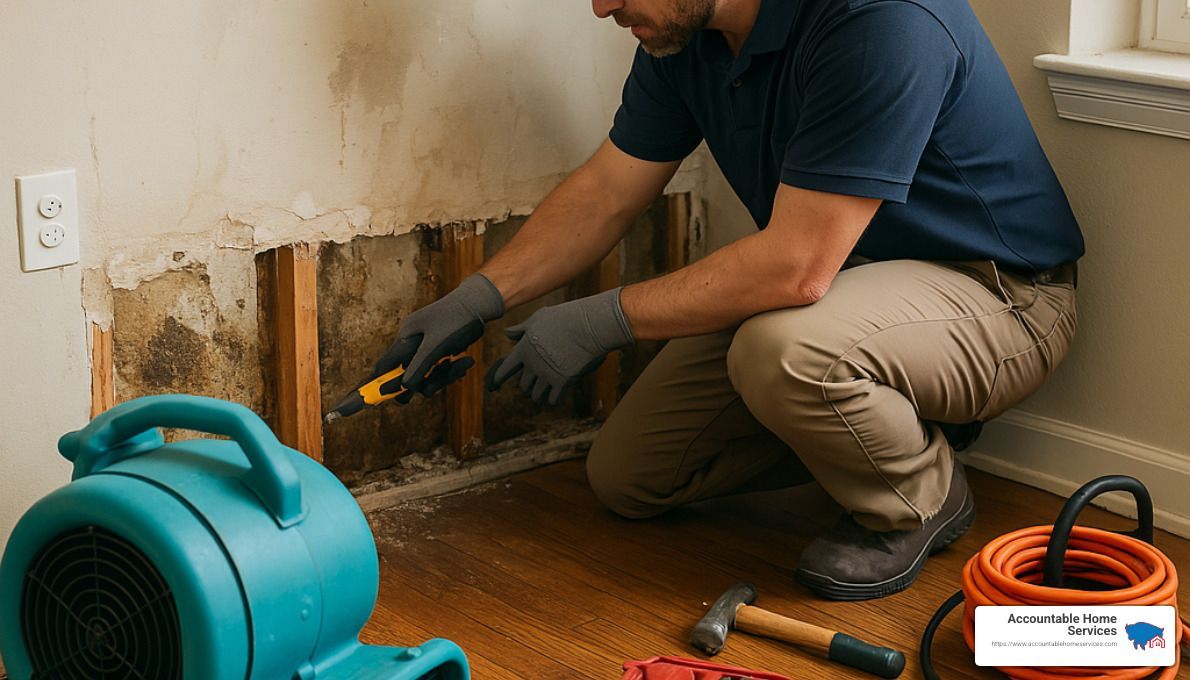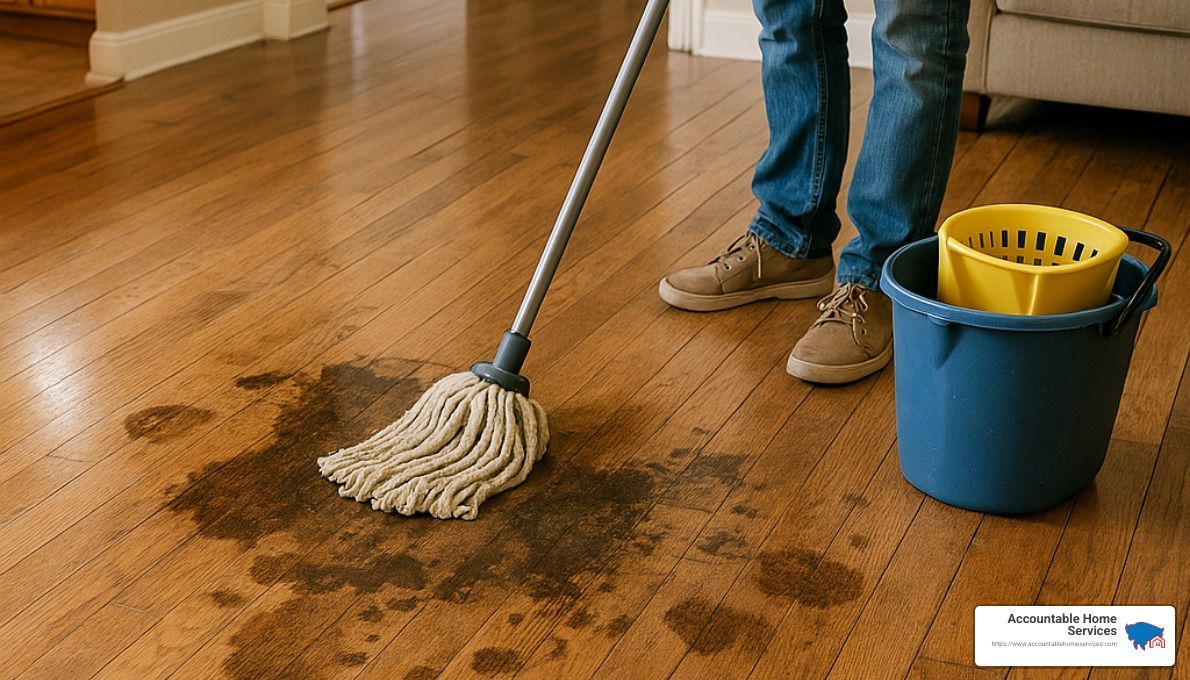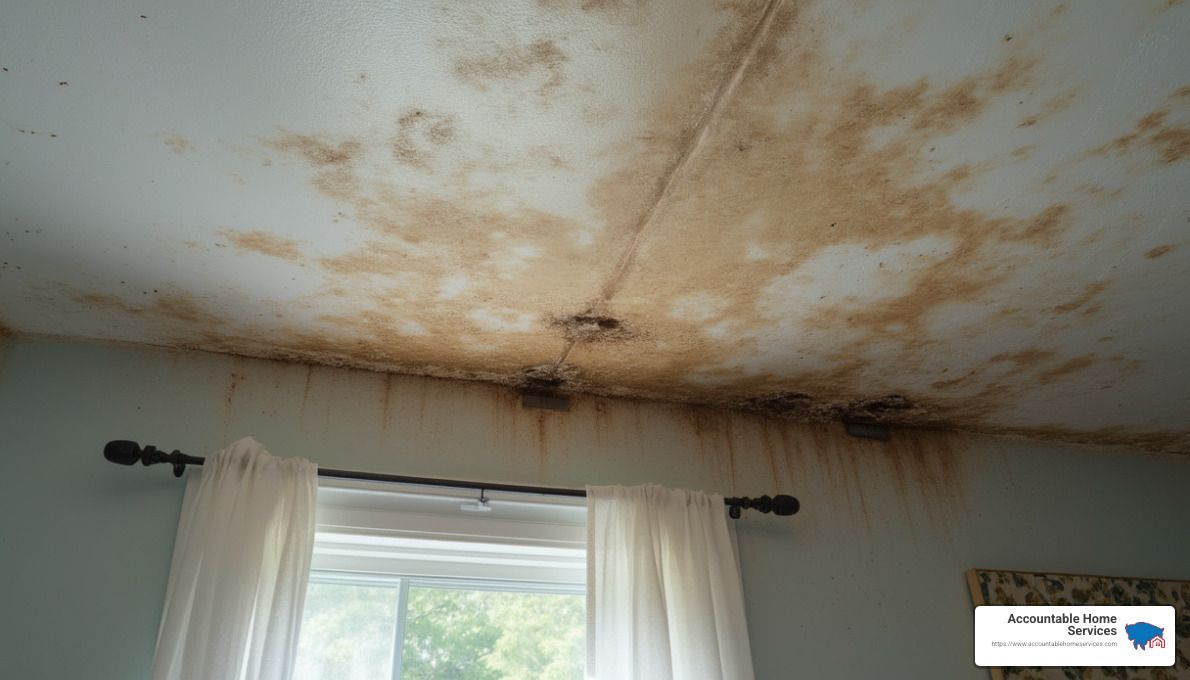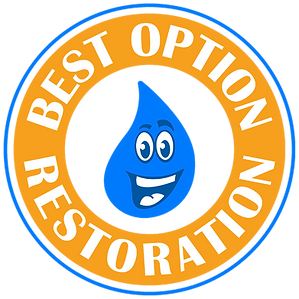Blog
Why Homeowners Are Talking About Thermography for Breast Health
When it comes to breast health, we're always on the lookout for comfortable, safe options. That's why thermography has been creating quite a buzz lately among health-conscious Denver residents.
Thermography is an imaging method that uses an infrared camera to map the surface temperature of your skin—no touching, no squeezing, and no radiation involved. If you're weighing your breast imaging options or have concerns about safety and comfort, you deserve to know what's really behind the hype.
As someone who's seen thermographic technology used in both home inspections and medical settings, I can tell you it has some genuine advantages—but also important limitations you should understand before making health decisions.
The appeal of thermography is understandable—who wouldn't prefer a screening method that involves no radiation and no discomfort? The technology detects heat patterns and blood flow changes that might indicate inflammation or increased vascular activity, which sometimes accompanies developing cancer.
Bottom Line:Thermography is a cool, radiation-free option for visualizing temperature patterns on your skin, but it should not replace mammograms for breast cancer screening. Major health organizations—including the FDA—recommend using thermography only as a backup, not as your main check.
"Thermography is not considered an alternative to mammography."— Healthline
Many of my clients at Accountable Home Services are health-conscious homeowners who appreciate knowing all their options. I'm Mike Martinez, a Denver native and business owner who understands that making informed decisions about both your home and health requires accurate information from someone you can trust.
The early detection promise of thermography is appealing, but the reality is that current evidence doesn't support using it as your primary screening tool. Think of it as an additional perspective rather than a complete picture of your breast health.
Just as we use thermal imaging in home inspections to complement other assessment methods—never as a standalone solution—thermography works best when used alongside traditional breast cancer screening approaches. The radiation-free nature is certainly a plus, but it doesn't outweigh the proven reliability of mammography for potentially life-saving early detection.
How Does Thermography Actually Work?
Ever wondered how we can "see" heat? That's exactly what thermography does. Using specialized infrared cameras, we can visualize the heat naturally radiating from your body—something our eyes can't detect on their own. These cameras capture thousands of precise temperature readings across your skin's surface, creating those colorful heat maps you might have seen.
The science behind this is fascinating. Every object with a temperature above absolute zero emits infrared radiation (a concept called black body radiation). Your skin has a property called emissivity that makes it particularly good at radiating heat, allowing these cameras to create detailed temperature profiles of your body.
The medical theory is straightforward: areas with increased blood flow—like those surrounding tumors or inflammation—tend to be warmer than surrounding tissues. These temperature differences create patterns that trained technicians can analyze.
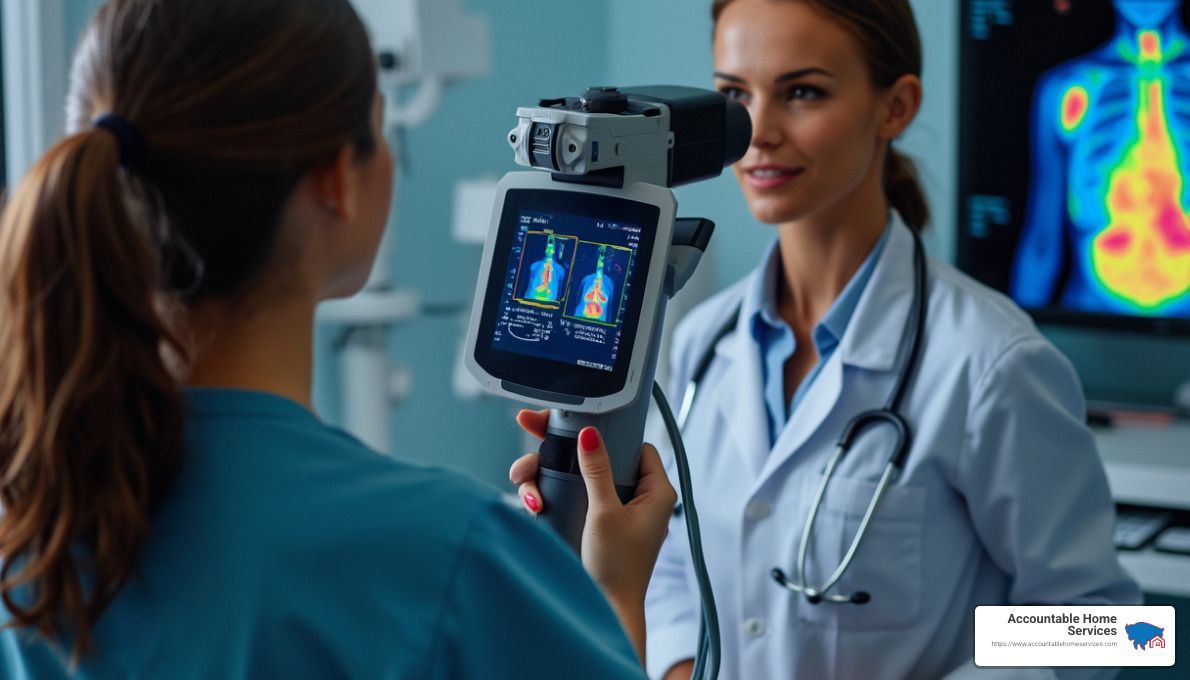
Types of Thermography You'll Hear About
When researching thermography, you'll likely encounter several different approaches:
Digital Infrared Thermal Imaging (DITI) is what most medical clinics offer—it maps the temperature patterns across your skin without any contact or radiation. It's completely painless and non-invasive.
MR-Thermography combines the temperature mapping concept with magnetic resonance imaging. This advanced technique is primarily used in research settings and for guiding certain treatments like focused ultrasound procedures.
Active or Dynamic Thermography takes a different approach by introducing a stimulus—like a cold compress—and then watching how your tissues respond temperature-wise. The rate of warming can provide additional diagnostic clues.
Temperature Gradient Studies focus specifically on comparing temperatures between symmetrical body areas. For breast examinations, technicians analyze differences between your left and right breast, looking for asymmetrical patterns that might suggest abnormalities.
I've seen this technology from both sides at Accountable Home Services. The infrared cameras we use to find hidden moisture behind walls or heat escaping through poor insulation in Denver homes work on the same principles as medical thermography. Both applications are about finding what's invisible to the naked eye by tracking heat patterns—whether it's a possible health concern or a potential home issue that needs addressing.
The ability to visualize temperature without physical contact makes thermography particularly appealing for many applications, though as we'll discuss in later sections, its promise and limitations need to be clearly understood, especially for medical uses.
Thermography for Breast Cancer Screening: Promise vs. Reality
When you first hear about thermography, it sounds almost magical—a camera that can "see" potential breast cancer without radiation or discomfort. The science behind it seems compelling: growing tumors need more blood supply, creating "hot spots" that infrared cameras can detect. But as someone who's worked with infrared technology in home inspections, I've learned that what sounds promising in theory doesn't always deliver in practice.
Hype vs. Hard Numbers in Thermography Studies
The research on thermography tells a sobering story that many clinics offering these services won't mention:
Studies show wildly inconsistent results when it comes to thermography's ability to detect breast cancer. While some cherry-picked studies claim sensitivity rates as high as 97%, most independent research finds much lower numbers—sometimes as low as 25%. This means thermography might miss three out of four cancers in some scenarios.
The specificity rates (how accurately it identifies non-cancerous tissue) aren't much better, ranging from a dismal 11% to 85% at best. This translates to a lot of false alarms that send women down a path of unnecessary worry and additional testing.
Perhaps most concerning was a landmark 1990 study involving over 10,000 women. The results? Thermography missed 72% of breast cancers that eventually developed. That's not a typo—it failed to detect nearly three-quarters of actual cancers.
"There is simply no evidence that breast thermography can take the place of mammography."— U.S. Food and Drug Administration
What's particularly tricky about thermography is that many factors can create "hot spots" that have nothing to do with cancer—your recent workout, where you are in your menstrual cycle, or even drinking a cup of coffee before your appointment. This leads to anxiety-inducing false positives that often require additional testing to resolve.
What Major Organizations Say About Thermography
When making health decisions, it helps to know what the experts think. Here's where major health organizations stand on thermography:
The FDA has issued multiple warnings about thermography, explicitly stating it should not replace mammograms. They've only cleared it as an "adjunct" tool—meaning it should be used alongside, never instead of, proven screening methods.
The American Cancer Society doesn't include thermography in its recommended screening guidelines, pointing to the lack of evidence supporting its effectiveness.
Major insurers like Aetna and the Centers for Medicare & Medicaid Services (CMS) typically don't cover thermography for breast screening. Their reasoning? The scientific evidence simply isn't there.
USPSTF (U.S. Preventive Services Task Force), which sets many of our national screening guidelines, doesn't recommend thermography in its breast cancer screening protocols.
As someone who values both cutting-edge technology and proven results, I find the data clear: thermography isn't ready to replace traditional screening methods. The promise is there, but the reality hasn't caught up.
Just as I wouldn't rely solely on thermal imaging to detect all potential water damage in your Denver home (we use multiple testing methods at Accountable Home Services), you shouldn't rely on thermography alone to protect your breast health. The stakes are simply too high.
Thermography vs. Mammography, Ultrasound & MRI: A Side-By-Side Look
When it comes to breast health screening, it's important to understand your options. I've spoken with many Denver homeowners who are confused about which screening tool might be right for them, so let's clear things up.
Mammography remains the gold standard in breast cancer detection. Using low-dose X-rays, mammograms can see deep inside breast tissue, catching many cancers when they're still small and highly treatable. For most women, this is still the recommended first-line screening tool.
Ultrasound serves as an excellent complementary tool, especially for women with dense breast tissue where mammograms might miss certain changes. It uses sound waves—no radiation—and is particularly good at determining whether a lump is solid or fluid-filled.
MRI provides incredibly detailed images using magnetic fields and is typically reserved for high-risk patients or situations requiring deeper investigation. While extremely sensitive, MRIs are also expensive and not necessary for routine screening.
Thermography, as we've discussed, only detects heat patterns on the skin's surface. While it offers the advantage of zero radiation and complete comfort (no compression), it simply cannot "see" what's happening deep inside breast tissue where most cancers begin.
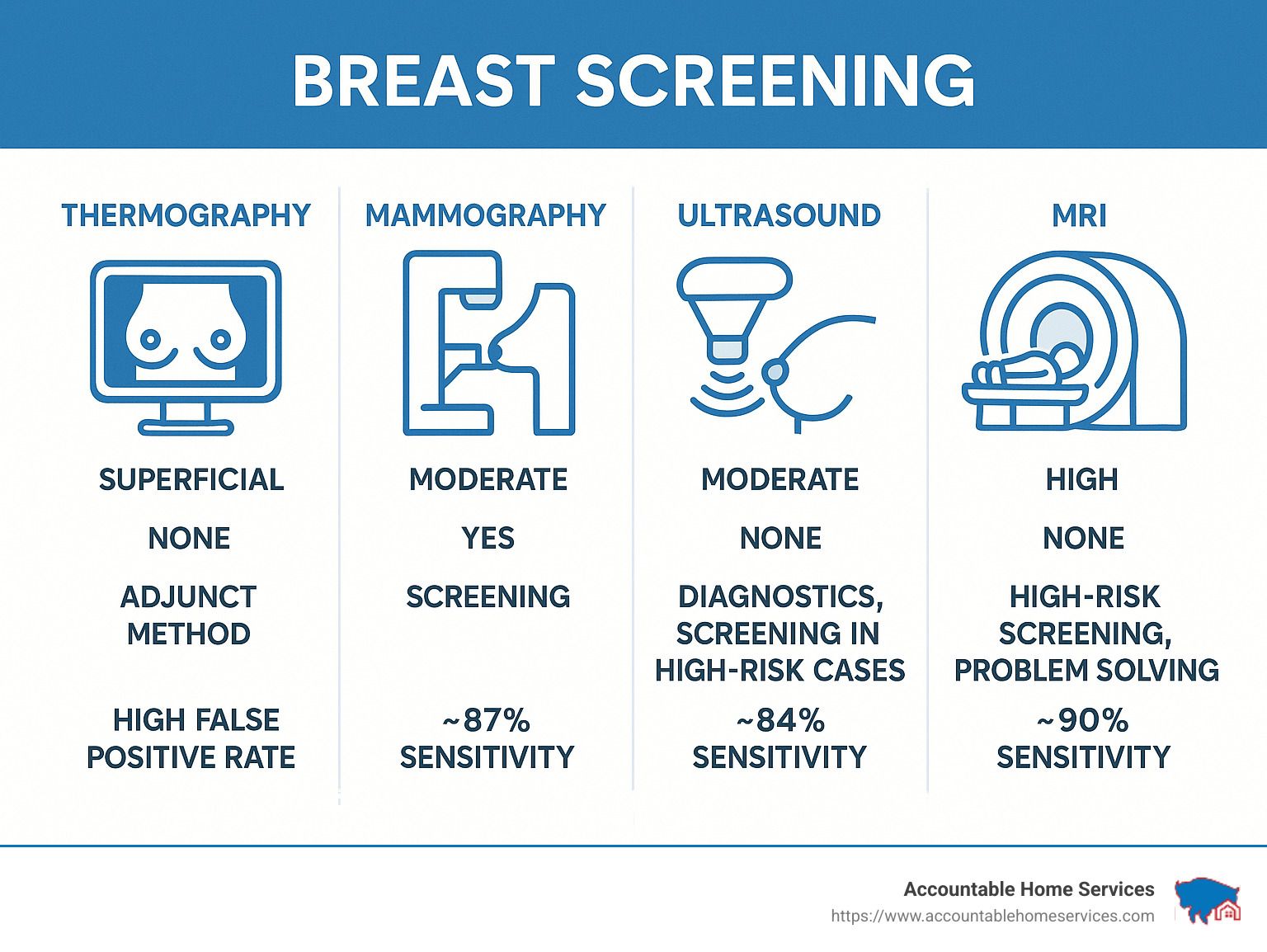
When Thermography Shines—and When It Doesn't
In my years working with different types of imaging at Accountable Home Services, I've learned that every technology has its sweet spot. For thermography, there are a few niche areas where it can be valuable:
As an adjunct tool for someone who absolutely cannot undergo mammography for medical reasons, thermography might provide some information—though it's important to understand its limitations.
Researchers sometimes use thermography for tracking blood flow patterns after reconstructive breast surgery, helping surgeons monitor healing.
Interestingly, thermography has a better negative predictive value than positive—meaning if it shows no abnormalities, that's somewhat reassuring. However, this isn't reliable enough for life-saving cancer screening.
At our company, we regularly use infrared thermography for home inspections—detecting water leaks behind walls, finding insulation gaps, and identifying electrical "hot spots" that could become fire hazards. For your house, thermographic imaging is incredibly valuable. For breast cancer screening? Not so much.
Can Thermography Replace Mammograms? (Short Answer: No)
The evidence is crystal clear on this point: thermography cannot replace mammograms. Every major medical organization—from the FDA to the American Cancer Society—emphasizes this fact. If you have breasts, you still need regular mammograms as your primary screening tool.
Here's why: Thermography only images the surface temperature of your skin. Most breast cancers begin deep inside breast tissue, in areas thermography simply cannot visualize. By the time a cancer grows large enough to create a detectable heat signature on the skin, it's often more advanced than if it had been caught earlier by mammography.
The cost range for these different screening methods varies significantly, with thermography typically ranging from $150-$500 per session, rarely covered by insurance. Mammograms, while sometimes involving some discomfort from compression, are usually covered by insurance and remain the most cost-effective way to detect breast cancer early.
For Denver homeowners who value both comfort and accuracy, having a conversation with your healthcare provider about your specific risk factors and screening needs is the best path forward.
Beyond the Breast: Other Clinical & Investigational Uses of Thermography
While thermography may not be the star player in breast cancer screening, it's finding its groove in other fascinating medical applications. Think of it as that versatile tool that might not excel at one specific job but brings unique value to many different situations.
As someone who uses thermal imaging regularly in home inspections, I've seen how powerful this technology can be when applied in the right context. The same principles that help us find hidden water leaks behind your walls are being used by medical professionals in some pretty innovative ways.
Musculoskeletal injuries practically light up on thermal imaging. Athletes with inflammation from sprains or strains show warm spots that help physical therapists target treatment. I've spoken with Denver sports medicine doctors who use thermography to track healing progress and pinpoint those stubborn trigger points that cause chronic pain.
For patients with peripheral arterial disease, thermography offers a non-invasive way to check blood flow problems. Medical studies show that when comparing limb temperatures, a difference of just 1.7°C between matching body parts can signal significant circulation issues—something that's particularly important for our Colorado seniors.
Diabetic foot monitoring is another area where this technology truly shines. By detecting subtle temperature changes, healthcare providers can predict potential ulcer sites before they develop—potentially saving limbs and lives. For someone with diabetes-related neuropathy who can't feel problems developing, these thermal scans offer an early warning system.
When it comes to burn assessment, thermography helps estimate healing potential and burn depth, though research shows it's not quite as accurate as newer technologies like laser Doppler imaging. Still, in a pinch, it provides valuable information without touching sensitive damaged skin.
For patients suffering from Complex Regional Pain Syndrome (CRPS)—a condition that causes intense, burning pain—thermography boasts impressive diagnostic power. Studies show up to 92% sensitivity and 94% specificity when using skin temperature asymmetry to confirm this challenging condition.
Research continues to explore applications in dry eye disease diagnosis, stroke rehabilitation progress tracking, and monitoring tissue health during plastic surgery procedures. The technology even enjoyed a moment in the spotlight during COVID-19, when those fever-screening cameras popped up in airports and public spaces worldwide.
Thermography as a Sports-Injury Tool
If you've ever tweaked your knee playing rec soccer in Washington Park or pulled a muscle hiking the Flatirons, you'll appreciate how thermography can help.
Rather than guessing where inflammation hides, thermal imaging creates a visual map of hot spots. Physical therapists and sports medicine doctors use these heat signatures to guide treatment exactly where it's needed. Recovery tracking becomes more objective—you can literally see improvement as inflammation cools down over weeks of rehab. For athletes dealing with trigger points and chronic issues, these thermal maps help pinpoint the exact spots requiring attention.
What I find most fascinating is how this mirrors what we do at Accountable Home Services. Just as we track moisture patterns in walls to prevent mold growth, sports medicine specialists track inflammation patterns in tissues to prevent further injury.
Medical Thermography in Everyday Clinics
Setting up medical thermography isn't quite as simple as pointing a camera and snapping a picture. Having used professional-grade thermal imaging equipment for years in home inspections, I can tell you that accuracy demands attention to detail.
A proper medical thermography setup requires a controlled environment with stable temperature (usually around 68-72°F) and no drafts that could skew readings. The equipment itself must be medical-grade infrared cameras with proper calibration—not the same units we use to find insulation gaps in attics.
Trained technicians are absolutely essential. Interpreting thermal patterns takes experience and knowledge of normal anatomical variation. Without standardized protocols (which, honestly, are still lacking in many clinics), results can vary significantly between operators.
This isn't a "point and shoot" situation—the quality of results depends heavily on the operator's skill and the equipment calibration. It's a bit like the difference between a professional home inspection and someone casually checking their house with a hardware store moisture meter.
When done right, though, medical thermography offers a unique window into the body's healing processes—one that doesn't involve radiation, contrast dyes, or invasive procedures. For certain conditions, that's a pretty cool advantage.
Limits, Risks & Gaps We Still Need to Close
Let's have a heart-to-heart about thermography's limitations. As someone who's worked with thermal imaging for home inspections, I can tell you that even the most advanced technology has its blind spots.
The truth is, medical thermography faces several significant challenges that make it less reliable than we'd hope for breast cancer screening:
Equipment quality matters enormously. At Accountable Home Services, we invest in professional-grade thermal cameras for home inspections—but not all clinics do the same. Some facilities use consumer-grade or repurposed equipment that simply doesn't have the sensitivity needed for medical diagnosis. This creates wildly inconsistent results from one clinic to another.
Environmental factors play havoc with readings. Imagine trying to get an accurate temperature reading in a drafty room, or right after a patient has rushed in from the cold Denver winter. Room temperature, humidity, and even whether you exercised that morning can dramatically alter your thermographic profile. One study found that simply drinking a cold beverage before imaging changed breast temperature patterns!
There's no universal playbook. Unlike mammography, which follows strict standardized protocols, thermography practices vary widely. This lack of standardization means one clinic's "concerning" finding might be another's "normal variation." It's like everyone playing by slightly different rules—not ideal when your health is on the line.
The financial reality check: If you're a Colorado homeowner hoping your insurance will cover thermography, I've got disappointing news. Most insurers, including those operating in our state, don't cover thermography for breast screening because they consider it investigational or unproven. This means potentially paying $150-400 out-of-pocket for a test that major medical organizations don't recommend as a primary screening tool.
Perhaps most concerning is the research gap. Many thermography studies are small, conducted by advocates rather than independent researchers, or use methodology that doesn't meet scientific standards. We need more large-scale, randomized controlled trials before thermography could be considered for broader clinical use.
Practical Tips If You're Considering a Thermogram
If you're still interested in thermography despite these limitations (perhaps as a complement to standard screening), here's my practical advice as someone who understands both thermal imaging and consumer protection:
Find a certified technician using medical-grade equipment. Ask about their specific training in breast thermography interpretation, not just general thermography certification. The quality of your results depends heavily on who's behind the camera and analyzing the images.
Never skip your mammogram or other recommended screening. Even the most enthusiastic thermography advocates should acknowledge it works best alongside—never instead of—conventional screening. Think of thermography as potentially adding information, not replacing proven methods.
Ask detailed questions about protocols. How strictly do they control room temperature? What patient preparation is required? Who interprets the scan—a technician or a physician with specialized training? A reputable clinic will have clear, consistent answers that align with best practices.
As we say when evaluating homes at Accountable Home Services: the right tool for the right job makes all the difference. Thermography has its place—but understanding its limitations is just as important as appreciating its potential.
Frequently Asked Questions about Thermography
Does a Thermogram Hurt or Expose Me to Radiation?
One of the biggest selling points of thermography is how gentle the experience is. Unlike mammograms, there's absolutely no compression or squeezing of breast tissue—which, let's be honest, can be uncomfortable for many women.
The procedure is completely non-invasive. You simply stand in front of a special infrared camera for a few minutes while it captures the heat patterns on your skin. No radiation whatsoever is used during a thermogram, making it different from X-rays or CT scans. For women concerned about radiation exposure, this aspect can feel reassuring, even though modern mammography uses very low radiation doses that experts consider safe.
Is Thermography Covered by Insurance in Colorado?
I wish I had better news on this front, but the reality is that thermography isn't typically covered by insurance in Colorado—or most other states, for that matter. Medicare, Medicaid, and private insurers generally classify thermography as "experimental" or "investigational" for breast cancer screening purposes, which means you'll likely be paying out-of-pocket.
The average cost runs between $175-$250 per scan, depending on the clinic and whether you're getting a full-body or focused exam. This is an important consideration when weighing your healthcare options, especially since mammograms (which are proven effective) are typically covered by insurance under preventive care benefits.
Can Thermography Detect Cancers Other than Breast?
While thermography has been studied for various inflammatory and vascular conditions throughout the body, its limitations remain consistent—it can only see temperature patterns on the skin's surface.
For most cancers, which develop deep within organs and tissues, thermography simply doesn't have the capability to provide reliable detection. The technology struggles to "see" anything more than a few millimeters below your skin, making it ineffective for detecting tumors in organs like the colon, lungs, or prostate.
If you're concerned about cancer screening, your best bet is to stick with the proven methods recommended by medical experts: colonoscopies for colon cancer, low-dose CT scans for those at high risk of lung cancer, and other evidence-based screening tools that have demonstrated their effectiveness in saving lives through early detection.
As a home restoration specialist who works with infrared technology to find hidden moisture and heat issues, I can tell you firsthand—tools are only valuable when used for their intended purpose. The same infrared technology that helps us find water damage behind your walls simply isn't designed to replace medical screening tools that can see deep inside your body.
Conclusion
So, is thermography the "cool" alternative to mammograms everyone's been talking about? Let's wrap this up with some straight talk:
Thermography offers some genuine advantages—it's completely safe, absolutely painless, and doesn't expose you to any radiation. For many Denver homeowners who value holistic approaches to health, that's understandably appealing.
But here's the reality check: when it comes to reliable breast cancer detection, thermography simply doesn't measure up to traditional screening methods. The science is clear—mammograms remain the best-proven way to catch cancer early, when treatment options are most effective and outcomes are best.
As a Colorado homeowner myself, I understand the desire to find gentler, less invasive health solutions. At Accountable Home Services, we apply this same careful evaluation to home problems—whether we're detecting hidden water damage in a Thornton basement or helping guide homeowners through tough decisions about mold remediation or restoration work.
Our team's advice mirrors what medical experts recommend: consider thermography as a potential supplement if you wish, but never as a replacement for the proven, guideline-recommended care that could save your life. Early detection matters, whether we're talking about water leaks or breast cancer.
If you have concerns about your breast health, have an open conversation with your doctor about the right screening schedule for your specific situation. And remember—just as you wouldn't want to cut corners with your health, the same applies to your home. When you need a trusted, family-owned restoration partner for water damage, fire recovery, mold remediation, or remodeling projects, we're here 24/7 to keep your Colorado home safe and sound.
For more information on protecting your home and your health, check out our water damage restoration services in Denver, or contact us for a free consultation.

